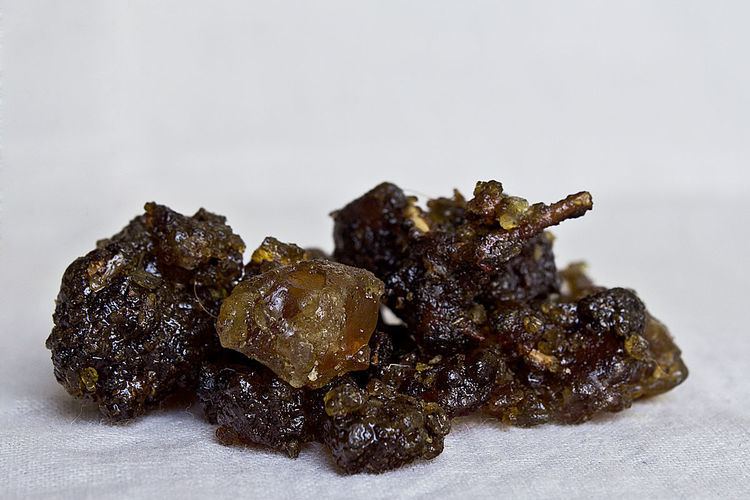 | ||
Bdellium /ˈdɛliəm/ (Hebrew bedolach), also bdellion, is a semi-transparent oleo-gum resin extracted from Commiphora wightii and from Commiphora africana trees growing in Ethiopia, Eritrea and sub-saharan Africa.
Contents
Composition
Bdellium consists of a water-soluble gum, a resin and an essential oil. The essential oil of Commiphora africana contains predominantly α-thujene, α- and β-pinene, and p-cymene.
Uses
Bdellium is used in perfumery, as incense and in traditional medicine. It is an adulterant of the more costly myrrh.
Name
Middle English, from Latin, from Greek βδέλλιον.
Commiphora africana resin is also known as African bdellium.
History
Theophrastus is perhaps the first classical author to mention Bdellium, if the report that came back from his informant in Alexander's expedition refers to Commiphora wightii: "In the region called Aria there is a thorn tree which produces a tear of resin, resembling myrrh in appearance and odour. It liquifies when the sun shines upon it."
Plautus in his play Curculio refers to it. Pliny the Elder, in his Natural History (12:36), describes the best bdellium coming from Bactria (identified as Commiphora wightii) as a "tree black in colour, and the size of the olive tree; its leaf resembles that of the oak and its fruit the wild fig", as well as bdellium coming from Nubia (identified as Commiphora africana). However, his descriptions seem to cover a range of strongly perfumed resins. The Periplus of the Erythraean Sea, of the 2nd century CE, reports that bdella are exported from the port of Barbarice at the mouth of the Indus. The Bactrian variety is known among Arabs as mokul.
The bdellium referred to by Dioscorides as "the bdellium imported from Petra" (De Materia Medica, 1:80) is probably the resin of Hyphaene thebaica, a species of palm. The Arabs call it "Jewish bdellium."
Bdellium is mentioned in the Bible (Genesis, 2:12; Numbers, 11:7). In both passages the Septuagint understands it as the name of some precious stone, as does Rashi, who interprets it as "a precious stone, crystal", and Saadiah Gaon, as "pearls". The Midrash gives two opinions. According to one, it is a precious stone, and according to the other the reference is to "the bedolaḥ of perfumers". In Genesis the Midrash decides in favor of the first interpretation because there it is associated with gold and onyx. In Numbers, the reference to bdellium is in the context of the manna eaten by the Israelites in the wilderness, which is said to have "the color of bdellium" (Numbers 11:7).
In China, bdellium, known as an hsi hsiang or "Parthian aromatic", was among the varieties of incense that reached China either along the Silk Route from Central Asia, or by sea. Later an hsi hsiang was applied to an East Indian substitute, gum benzoin from Sumatra.
Bdellium was an ingredient in the prescriptions of ancient physicians from Galen to Paul of Aegina, and in the Greater Kuphi.
Isidore of Seville reports in his Etymologiae (XVII.viii.6) that bdellium comes from trees in India and Arabia, the Arabian variety being better as it is smooth, whitish and smells good; the Indian variety is a dirty black.
